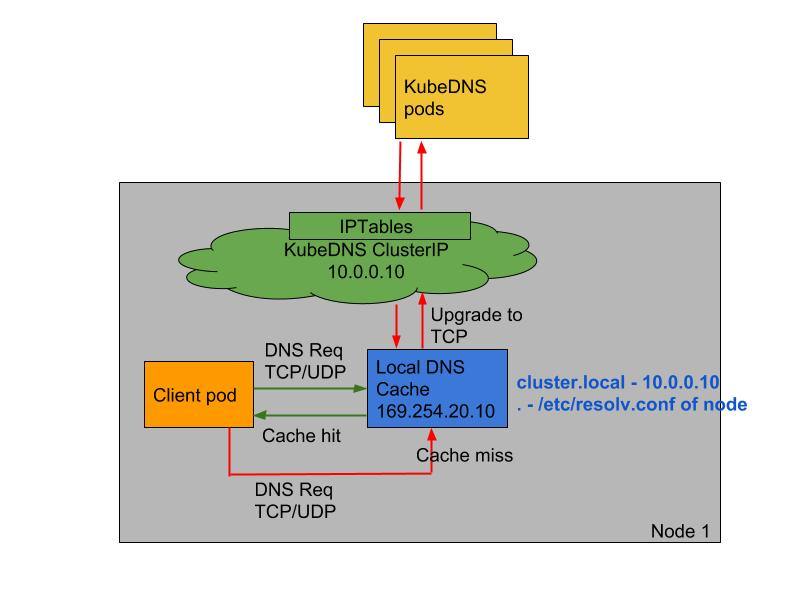概况
之前在解决 CoreDNS 的5秒超时问题的时候,除了通过 dnsConfig 去强制使用 tcp 方式解析之外,我们提到过使用 NodeLocal DNSCache 来解决这个问题。NodeLocal DNSCache 通过在集群节点上运行一个 DaemonSet 来提高 clusterDNS 性能和可靠性。处于 ClusterFirst 的 DNS 模式下的 Pod 可以连接到 kube-dns 的 serviceIP 进行 DNS 查询。通过 kube-proxy 组件添加的 iptables 规则将其转换为 CoreDNS 端点。通过在每个集群节点上运行 DNS 缓存,NodeLocal DNSCache 可以缩短 DNS 查找的延迟时间、使 DNS 查找时间更加一致,以及减少发送到 kube-dns 的 DNS 查询次数。
在集群中运行 NodeLocal DNSCache 有如下几个好处:
- 如果本地没有 CoreDNS 实例,则具有最高 DNS QPS 的 Pod 可能必须到另一个节点进行解析,使用 NodeLocal DNSCache 后,拥有本地缓存将有助于改善延迟
- 跳过 iptables DNAT 和连接跟踪将有助于减少
conntrack竞争并避免 UDP DNS 条目填满conntrack表(常见的5s超时问题就是这个原因造成的) - 从本地缓存代理到 kube-dns 服务的连接可以升级到 TCP,TCP conntrack 条目将在连接关闭时被删除,而 UDP 条目必须超时(默认 nf_conntrack_udp_timeout 是 30 秒)
- 将 DNS 查询从 UDP 升级到 TCP 将减少归因于丢弃的 UDP 数据包和 DNS 超时的尾部等待时间,通常长达 30 秒(3 次重试+ 10 秒超时)

安装使用
要安装 NodeLocal DNSCache 也非常简单,直接获取官方的资源清单即可:1
$ wget https://github.com/kubernetes/kubernetes/raw/master/cluster/addons/dns/nodelocaldns/nodelocaldns.yaml
该资源清单文件中包含几个变量,其中:
__PILLAR__DNS__SERVER__:表示kube-dns这个 Service 的 ClusterIP,可以通过命令kubectl get svc -n kube-system | grep kube-dns | awk '{ print $3 }'获取。__PILLAR__LOCAL__DNS__:表示 DNSCache 本地的 IP,默认为 169.254.20.10__PILLAR__DNS__DOMAIN__:表示集群域,默认就是 cluster.local
另外还有两个参数 __PILLAR__CLUSTER__DNS__ 和 __PILLAR__UPSTREAM__SERVERS__,这两个参数会通过镜像 1.15.6 版本以上的去进行配置,对应的值来源于 kube-dns 的 ConfigMap 和定制的 Upstream Server 配置。直接执行如下所示的命令即可安装:1
2
3
4
5$ sed 's/k8s.gcr.io/cnych/g
s/__PILLAR__DNS__SERVER__/10.96.0.10/g
s/__PILLAR__LOCAL__DNS__/169.254.20.10/g
s/__PILLAR__DNS__DOMAIN__/cluster.local/g' nodelocaldns.yaml |
kubectl apply -f -
可以通过如下命令来查看对应的 Pod 是否已经启动成功:1
2
3
4
5
6
7
8$ kubectl get pods -n kube-system | grep node-local-dns
node-local-dns-8zm2f 1/1 Running 0 9m54s
node-local-dns-dd4xg 1/1 Running 0 9m54s
node-local-dns-hs8qq 1/1 Running 0 9m54s
node-local-dns-pxfxn 1/1 Running 0 9m54s
node-local-dns-stjm9 1/1 Running 0 9m54s
node-local-dns-wjxvz 1/1 Running 0 9m54s
node-local-dns-wn5wc 1/1 Running 0 7m49s
需要注意的是这里使用 DaemonSet 部署 node-local-dns 使用了
hostNetwork=true,会占用宿主机的 8080 端口,所以需要保证该端口未被占用。
但是到这里还没有完,如果 kube-proxy 组件使用的是 ipvs 模式的话我们还需要修改 kubelet 的 --cluster-dns 参数,将其指向 169.254.20.10,Daemonset 会在每个节点创建一个网卡来绑这个 IP,Pod 向本节点这个 IP 发 DNS 请求,缓存没有命中的时候才会再代理到上游集群 DNS 进行查询。 iptables 模式下 Pod 还是向原来的集群 DNS 请求,节点上有这个 IP 监听,会被本机拦截,再请求集群上游 DNS,所以不需要更改 --cluster-dns 参数。
ipvs使用localDNS修改方式一
由于我这里使用的是 kubeadm 安装的 1.16 版本的集群,所以我们只需要替换节点上 /var/lib/kubelet/config.yaml 文件中的 clusterDNS 这个参数值,然后重启即可。1
2$ sed -i 's/10.96.0.10/169.254.20.10/g' /var/lib/kubelet/config.yaml
$ systemctl daemon-reload && systemctl restart kubelet
ipvs使用localDNS修改方式二 (不推荐)
我们也可以完全在官方的 DaemonSet 资源对象中添加一个 initContainer 来完成这个工作。1
2
3
4
5
6
7
8
9
10
11
12
13
14
15
16
17
18
19
20
21
22
23
24initContainers: # ipvs模式下需要修改dns配置,重启kubelet
- name: setup
image: alpine
tty: true
stdin: true
securityContext:
privileged: true
command:
- nsenter
- --target
- "1"
- --mount
- --uts
- --ipc
- --net
- --pid
- --
- bash
- -c
- |
# 确保 kubelet --cluster-dns 被设置为 169.254.20.10
echo "Configuring kubelet --cluster-dns=169.254.20.10"
sed -i 's/10.96.0.10/169.254.20.10/g' /var/lib/kubelet/config.yaml
systemctl daemon-reload && systemctl restart kubelet
但是需要注意的是对于线上环境还是不推荐用上面的方式,因为它会优先将 kubelet 的 cluster-dns 参数进行修改,然后再去安装 NodeLocal,这中间毕竟有一段真空期。
验证
待 node-local-dns 安装配置完成后,我们可以部署一个新的 Pod 来验证下:(test-node-local-dns.yaml)1
2
3
4
5
6
7
8
9apiVersion: v1
kind: Pod
metadata:
name: test-node-local-dns
spec:
containers:
- name: local-dns
image: busybox
command: ["/bin/sh", "-c", "sleep 60m"]
直接部署:1
2
3
4
5
6$ kubectl apply -f test-node-local-dns.yaml
$ kubectl exec -it test-node-local-dns /bin/sh
/ # cat /etc/resolv.conf
nameserver 169.254.20.10
search default.svc.cluster.local svc.cluster.local cluster.local
options ndots:5
我们可以看到 nameserver 已经变成 169.254.20.10 了,当然对于之前的历史 Pod 要想使用 node-local-dns 则需要重建,当然如果要想去跟踪 DNS 的解析过程的话可以去通过抓包来观察。
番外篇
在使用了NodeLocal DNSCache后,如果在配置自定义域名?
首先我们需要在 CoreDNS 的 ConfigMap 中添加 hosts 插件:1
2
3
4hosts {
192.168.3.211 git.k8s.local
fallthrough
}
其次我们需要修改 NodeLocal DNSCache 的 ConfigMap,当前配置如下:1
2
3
4
5
6
7
8
9
10
11
12
13
14
15
16
17
18
19
20
21
22
23
24
25
26
27
28
29
30
31
32
33
34
35
36
37
38
39
40
41
42
43
44
45
46
47
48
49cluster.local:53 {
errors
cache {
success 9984 30
denial 9984 5
}
reload
loop
bind 169.254.20.10 10.96.0.10
forward . 10.96.207.156 {
force_tcp
}
prometheus :9253
health 169.254.20.10:8080
}
in-addr.arpa:53 {
errors
cache 30
reload
loop
bind 169.254.20.10 10.96.0.10
forward . 10.96.207.156 {
force_tcp
}
prometheus :9253
}
ip6.arpa:53 {
errors
cache 30
reload
loop
bind 169.254.20.10 10.96.0.10
forward . 10.96.207.156 {
force_tcp
}
prometheus :9253
}
.:53 {
errors
cache 30
reload
loop
bind 169.254.20.10 10.96.0.10
forward . /etc/resolv.conf {
force_tcp
}
prometheus :9253
}
...
分析上面的 LocalDNS 的配置信息,其中 10.96.0.10 为 CoreDNS 的 Service ClusterIP,169.254.20.10 为 LocalDNS 的 IP 地址,10.96.207.156 是 LocalDNS 新建的一个 Service ClusterIP,该 Service 和 CoreDNS 一样都是关联以前的 CoreDNS 的 Endpoints 列表。
仔细观察可以发现 cluster.local、in-addr.arpa 以及 ip6.arpa 都会通过 forward 转发到 10.96.207.156,也就是去 CoreDNS 解析,其他的则是 forward . /etc/resolv.conf 通过 resolv.conf 文件去解析,该文件的内容如下所示:1
2
3nameserver 169.254.20.10
search default.svc.cluster.local svc.cluster.local cluster.local
options ndots:5
所以当我们解析域名 git.k8s.local 的时候需要走一遍搜索域,而 k8s.local 不在 cluster.local、in-addr.arpa 以及 ip6.arpa 这些域中,所以就会走到 /etc/resolv.conf 去解析。这样就会导致 git.k8s.local 无法进行解析。这个时候我们需要把 forward . /etc/resolv.conf 更改成 forward . 10.96.207.156,这样就会去 CoreDNS 解析了,在 NodeLocalDNS 的 ConfigMap 中做如下的修改即可:1
2
3
4
5
6
7
8
9
10
11
12
13
14$ kubectl edit cm node-local-dns -n kube-system
......
.:53 {
errors
cache 30
reload
loop
bind 169.254.20.10 10.96.0.10
forward . __PILLAR__CLUSTER__DNS__ {
force_tcp
}
prometheus :9253
}
......
同样修改完成后,需要重建 NodeLocalDNS 的 Pod 才会生效。
__PILLAR__CLUSTER__DNS__和__PILLAR__UPSTREAM__SERVERS__这两个参数在镜像 1.15.6 版本以上中会自动进行配置,对应的值来源于 kube-dns 的 ConfigMap 和定制的 Upstream Server 地址。
参考:明阳的博客

